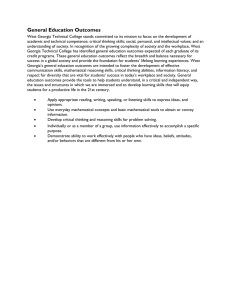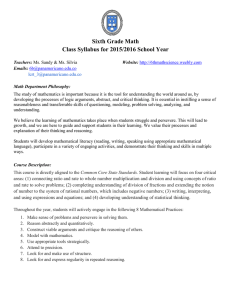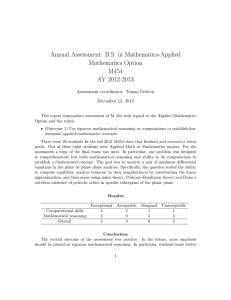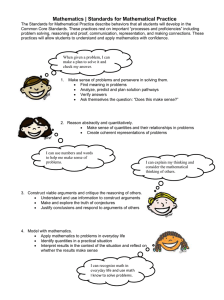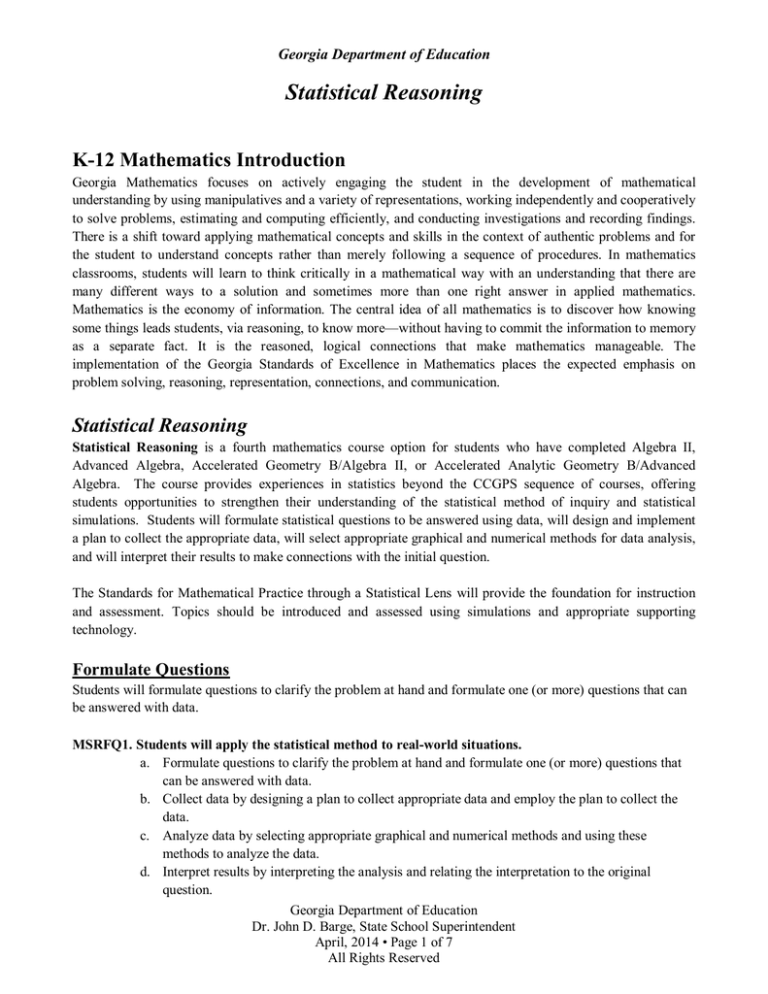
Georgia Department of Education
Statistical Reasoning
K-12 Mathematics Introduction
Georgia Mathematics focuses on actively engaging the student in the development of mathematical
understanding by using manipulatives and a variety of representations, working independently and cooperatively
to solve problems, estimating and computing efficiently, and conducting investigations and recording findings.
There is a shift toward applying mathematical concepts and skills in the context of authentic problems and for
the student to understand concepts rather than merely following a sequence of procedures. In mathematics
classrooms, students will learn to think critically in a mathematical way with an understanding that there are
many different ways to a solution and sometimes more than one right answer in applied mathematics.
Mathematics is the economy of information. The central idea of all mathematics is to discover how knowing
some things leads students, via reasoning, to know more—without having to commit the information to memory
as a separate fact. It is the reasoned, logical connections that make mathematics manageable. The
implementation of the Georgia Standards of Excellence in Mathematics places the expected emphasis on
problem solving, reasoning, representation, connections, and communication.
Statistical Reasoning
Statistical Reasoning is a fourth mathematics course option for students who have completed Algebra II,
Advanced Algebra, Accelerated Geometry B/Algebra II, or Accelerated Analytic Geometry B/Advanced
Algebra. The course provides experiences in statistics beyond the CCGPS sequence of courses, offering
students opportunities to strengthen their understanding of the statistical method of inquiry and statistical
simulations. Students will formulate statistical questions to be answered using data, will design and implement
a plan to collect the appropriate data, will select appropriate graphical and numerical methods for data analysis,
and will interpret their results to make connections with the initial question.
The Standards for Mathematical Practice through a Statistical Lens will provide the foundation for instruction
and assessment. Topics should be introduced and assessed using simulations and appropriate supporting
technology.
Formulate Questions
Students will formulate questions to clarify the problem at hand and formulate one (or more) questions that can
be answered with data.
MSRFQ1. Students will apply the statistical method to real-world situations.
a. Formulate questions to clarify the problem at hand and formulate one (or more) questions that
can be answered with data.
b. Collect data by designing a plan to collect appropriate data and employ the plan to collect the
data.
c. Analyze data by selecting appropriate graphical and numerical methods and using these
methods to analyze the data.
d. Interpret results by interpreting the analysis and relating the interpretation to the original
question.
Georgia Department of Education
Dr. John D. Barge, State School Superintendent
April, 2014 • Page 1 of 7
All Rights Reserved
Georgia Department of Education
Statistical Reasoning
MSRFQ2. Students will identify whether the data are categorical or quantitative (numerical).
Students will be able to identify the difference between categorical and quantitative
(numerical) data.
a. Determine the appropriate graphical display for each type of data.
b. Determine the type of data used to produce a given graphical display.
Collect Data
Students will design and implement a plan to collect the appropriate data to answer the statistical question.
MSRCD1. Students will distinguish between a population distribution, a sample data distribution, and a
sampling distribution.
a. Students will identify the three types of distributions.
i. Recognize a population distribution has fixed values of its parameters that are usually
unknown.
ii. Recognize a sample data distribution is taken from a population distribution and the data
distribution is what is seen in practice hoping it approximates the population distribution.
iii. Recognize a sampling distribution is the distribution of a sample statistic (such as a sample
mean or a sample proportion) obtained from repeated samples. The sampling distribution
provides the key for determining how close to expect a sample statistic approximates the
population parameter.
b. Students will create sample data distributions and a sampling distribution.
i. Create a sample data distribution by taking a sample from a defined population and
summarizing the data in a distribution.
ii. Create a sampling distribution of a statistic by taking repeated samples from a population
(either hands-on or by simulation with technology).
MSRCD2. Students will understand that randomness should be incorporated into a sampling or
experimental procedure.
Students will be able to implement a reasonable random method for selecting a sample or
for assigning treatments in an experiment.
a. Implement a simple random sample.
b. Randomly assign treatments to experimental subjects or objects.
MSRCD3. Students will distinguish between the three types of study designs for collecting data
(sample survey, experiment, and observational study) and will know the scope of the
interpretation for each design type.
Students will be able to distinguish between the three types of study designs for collecting
data (sample survey, experiment, and observational study) and know the scope of the
interpretation for each design type.
a. Determine the type of study design appropriate for answering a statistical question.
b. Determine the appropriate scope of inference for the study design used.
Georgia Department of Education
Dr. John D. Barge, State School Superintendent
April, 2014 • Page 2 of 7
All Rights Reserved
Georgia Department of Education
Statistical Reasoning
MSRCD4. Students will distinguish between the role of randomness and the role of sample size
with respect to using a statistic from a sample to estimate a population parameter.
Students will be able to distinguish the roles of randomization and sample size with designing
studies.
a. Recognize that randomization reduces bias where bias occurs when certain outcomes are
systematically more likely to appear.
b. Recognize that random selection from a population plays a different role than random
assignment in an experiment.
c. Recognize that sample size impacts the precision with which estimates of the population
parameters can be made (larger the sample size the more precision).
Analyze Data
Students will select appropriate graphical and numerical methods and use these methods to analyze the data.
MSRAD1. Students will use distributions to identify the key features of the data collected.
Students will describe the distribution for quantitative and categorical data.
a. Describe the distribution for quantitative data.
i. Describe and interpret the shape of the distribution.
ii. Describe and interpret the measures of center for the distribution.
iii. Describe and interpret the patterns in variability for the distribution.
iv. Describe and interpret any outliers or gaps in the distribution.
b. Describe the distribution for categorical data.
i. Describe and interpret the modal category for the distribution.
ii. Describe and interpret patterns that exist for the distribution.
MSRAD2. Students will use distributions to compare two or more groups.
Students will compare two or more groups by analyzing distributions.
a. Construct appropriate graphical displays of distributions.
b. Use graphical and numerical attributes of distributions to make comparisons between
distributions.
MSRAD3. Students will determine if an association exists between two variables (pattern or trend in
bivariate data) and use values of one variable to predict values of another variable.
Students will analyze associations between variables and make predictions from one variable to
another.
a. Analyze associations between two variables.
i. Create scatter plots for two-variable numerical data.
ii. Create two-way tables for two-variable categorical data.
iii. Analyze patterns and trends in data displays.
b. Make predictions and draw conclusions from two-variable data based on data displays.
c. Distinguish between association and causation.
Georgia Department of Education
Dr. John D. Barge, State School Superintendent
April, 2014 • Page 3 of 7
All Rights Reserved
Georgia Department of Education
Statistical Reasoning
Interpret Results
Students will interpret results and make connections to the original question.
MSRIR1. Students will ask if the difference between two sample proportions or two sample means is due
to random variation or if the difference is significant.
Students will be able to determine if there are differences between two population parameters or
treatment effects.
a. Using simulation, determine the appropriate model to decide if there is a difference between
two population parameters.
b. Using simulation, determine the appropriate model to decide if there is a difference between
two treatment effects.
MSRIR2. Students will understand that when randomness is incorporated into a sampling or
experimental procedure, probability provides a way to describe the ‘long-run’ behavior of a
statistic as described by its sampling distribution.
Students will be able to create simulated sampling distributions and understand how to use the
sampling distribution to make predictions about a population parameter(s) or the difference in
treatment effects.
a.
Create an appropriate simulated sampling distribution (using technology) and develop a margin
of error.
b.
Create an appropriate simulated sampling distribution (using technology) and develop a p-value.
Terms/Symbols: population distribution, sample data distribution, sampling distribution, sampling proportion,
sample statistic, population parameter, randomness, simple random sample, treatments, sample survey,
experiment, observational study, inference, bias, modal category, bivariate data, significant differences, margin
of error, p-value.
Mathematics | Standards for Mathematical Practice through a Statistical Lens
Mathematical Practices are listed with each grade’s mathematical content standards to reflect the
need to connect the mathematical practices to mathematical content in instruction.
The Standards for Mathematical Practice through a Statistical Lens describe varieties of expertise that
mathematics educators at all levels should seek to develop in their students. These practices rest on important
“processes and proficiencies” with longstanding importance in mathematics education. The first of these are the
NCTM process standards of problem solving, reasoning and proof, communication, representation, and
connections. The second are the strands of mathematical proficiency specified in the National Research
Council’s report Adding It Up: adaptive reasoning, strategic competence, conceptual understanding
(comprehension of mathematical concepts, operations and relations), procedural fluency (skill in carrying out
procedures flexibly, accurately, efficiently and appropriately), and productive disposition (habitual inclination to
see mathematics as sensible, useful, and worthwhile, coupled with a belief in diligence and one’s own efficacy).
Georgia Department of Education
Dr. John D. Barge, State School Superintendent
April, 2014 • Page 4 of 7
All Rights Reserved
Georgia Department of Education
Statistical Reasoning
1. Make sense of problems and persevere in solving them.
Statistically proficient students start by explaining to themselves the meaning of a problem and looking for entry
points to its solution. They analyze givens, constraints, relationships, and goals. They make conjectures about
the form and meaning of the solution and plan a solution pathway rather than simply jumping into a solution
attempt. They consider analogous problems, and try special cases and simpler forms of the original problem in
order to gain insight into its solution. They monitor and evaluate their progress and change course if necessary.
Older students might, depending on the context of the problem, transform algebraic expressions or change the
viewing window on their graphing calculator to get the information they need. Statistically proficient students
can explain correspondences between equations, verbal descriptions, tables, and graphs or draw diagrams of
important features and relationships, graph data, and search for regularity or trends. Younger students might rely
on using concrete objects or pictures to help conceptualize and solve a problem. Statistically proficient students
check their answers to problems using a different method, and they continually ask themselves, “Does this make
sense?” They can understand the approaches of others to solving complex problems and identify
correspondences between different approaches.
2. Reason abstractly and quantitatively.
Statistically proficient students make sense of quantities and their relationships in problem situations. They
bring two complementary abilities to bear on problems involving quantitative relationships: the ability to
decontextualize—to abstract a given situation and represent it symbolically and manipulate the representing
symbols as if they have a life of their own, without necessarily attending to their referents—and the ability to
contextualize, to pause as needed during the manipulation process in order to probe into the referents for the
symbols involved. Quantitative reasoning entails habits of creating a coherent representation of the problem at
hand; considering the units involved; attending to the meaning of quantities, not just how to compute them; and
knowing and flexibly using different properties of operations and objects.
3. Construct viable arguments and critique the reasoning of others.
Statistically proficient students understand and use stated assumptions, definitions, and previously established
results in constructing arguments. They make conjectures and build a logical progression of statements to
explore the truth of their conjectures. They are able to analyze situations by breaking them into cases, and can
recognize and use counterexamples. They justify their conclusions, communicate them to others, and respond to
the arguments of others. They reason inductively about data, making plausible arguments that take into account
the context from which the data arose. Statistically proficient students are also able to compare the effectiveness
of two plausible arguments, distinguish correct logic or reasoning from that which is flawed, and—if there is a
flaw in an argument—explain what it is. Elementary students can construct arguments using concrete referents
such as objects, drawings, diagrams, and actions. Such arguments can make sense and be correct, even though
they are not generalized or made formal until later grades. Later, students learn to determine domains to which
an argument applies. Students at all grades can listen or read the arguments of others, decide whether they make
sense, and ask useful questions to clarify or improve the arguments.
4. Model with mathematics.
Statistically proficient students can apply the mathematics they know to solve problems arising in everyday life,
society, and the workplace. In early grades, this might be as simple as writing an addition equation to describe a
situation. In middle grades, a student might apply proportional reasoning to plan a school event or analyze a
Georgia Department of Education
Dr. John D. Barge, State School Superintendent
April, 2014 • Page 5 of 7
All Rights Reserved
Georgia Department of Education
Statistical Reasoning
problem in the community. By high school, a student might use geometry to solve a design problem or use a
function to describe how one quantity of interest depends on another. Statistically proficient students who can
apply what they know are comfortable making assumptions and approximations to simplify a complicated
situation, realizing that these may need revision later. They are able to identify important quantities in a practical
situation and map their relationships using such tools as diagrams, two-way tables, graphs, flowcharts and
formulas. They can analyze those relationships statistically to draw conclusions. They routinely interpret their
statistical results in the context of the situation and reflect on whether the results make sense, possibly
improving the model if it has not served its purpose.
5. Use appropriate tools strategically.
Statistically proficient students consider the available tools when solving a statistical problem. These tools might
include pencil and paper, concrete models, a ruler, a protractor, a calculator, a spreadsheet, a computer algebra
system, a statistical package, or dynamic geometry software. Proficient students are sufficiently familiar with
tools appropriate for their grade or course to make sound decisions about when each of these tools might be
helpful, recognizing both the insight to be gained and their limitations. For example, statistically proficient high
school students analyze graphs of functions and solutions generated using a graphing calculator. They detect
possible errors by strategically using estimation and other mathematical knowledge. When making statistical
models, they know that technology can enable them to visualize the results of varying assumptions, explore
consequences, and compare predictions with data. Statistically proficient students at various grade levels are
able to identify relevant external statistical resources, such as digital content located on a website, and use them
to pose or solve problems. They are able to use technological tools to explore and deepen their understanding of
concepts.
6. Attend to precision.
Statistically proficient students try to communicate precisely to others. They use clear definitions in discussion
with others and in their own reasoning. They state the meaning of the symbols they choose. They are careful
about specifying units of measure, and labeling axes to clarify the correspondence with quantities in a problem.
They calculate accurately and efficiently, express numerical answers with a degree of precision appropriate for
the problem context. In the elementary grades, students give carefully formulated explanations to each other. By
the time they reach high school they have learned to examine claims and make explicit use of definitions.
7. Look for and make use of structure.
Statistically proficient students look closely to discern a pattern or structure. Patterns are prevalent in statistics
and can often be quantified. Randomization provides the foundation for identifying patterns in variability,
thereby allowing students to quantify uncertainty.
8. Look for and express regularity in repeated reasoning.
Statistically proficient students notice if calculations are repeated, and look both for general methods and for
shortcuts. As they work to solve a problem, statistically proficient students maintain oversight of the process,
while attending to the details. They continually evaluate the reasonableness of their results in the context of the
statistical question.
Georgia Department of Education
Dr. John D. Barge, State School Superintendent
April, 2014 • Page 6 of 7
All Rights Reserved
Georgia Department of Education
Statistical Reasoning
Connecting the Standards for Mathematical Practice through a Statistical Lens to the Standards
for Statistical Reasoning Content
The Standards for Mathematical Practice through a Statistical Lens describe ways in which developing student
practitioners of the discipline of statistics increasingly ought to engage with the subject matter as they grow in
statistical maturity and expertise throughout the elementary, middle, and high school years. Designers of
curricula, assessments, and professional development should all attend to the need to connect the mathematical
practices through a statistical lens to statistical content in statistical instruction.
The Standards for Statistical Reasoning Content are a balanced combination of procedure and understanding.
Expectations that begin with the word “understand” are often especially good opportunities to connect the
practices to the content. Students who lack understanding of a topic may rely on procedures too heavily.
Without a flexible base from which to work, they may be less likely to consider analogous problems, represent
problems coherently, justify conclusions, apply the statistics to practical situations, use technology mindfully to
work with the statistics, explain the statistics accurately to other students, step back for an overview, or deviate
from a known procedure to find a shortcut. In short, a lack of understanding effectively prevents a student from
engaging in the statistical practices.
In this respect, those content standards which set an expectation of understanding are potential “points of
intersection” between the Standards for Statistical Reasoning Content and the Standards for Mathematical
Practice through a Statistical Lens. These points of intersection are intended to be weighted toward central and
generative concepts in the school mathematics curriculum that most merit the time, resources, innovative
energies, and focus necessary to qualitatively improve the curriculum, instruction, assessment, professional
development, and student achievement in statistics.
Georgia Department of Education
Dr. John D. Barge, State School Superintendent
April, 2014 • Page 7 of 7
All Rights Reserved

